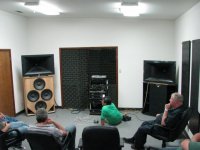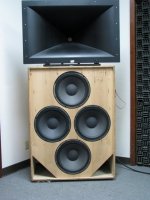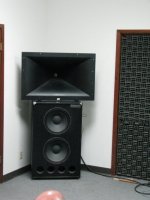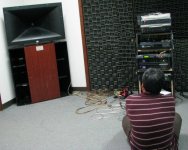Don't confuse the poster. I really have no idea what the point was of the first paragraph in your post... There is no direct link between Qts and distortion. "Colourarion" could be from other sources (cabinet, re-radiated sound, etc.) and not just the driver.Hi dipankar862 in response to the second part of your post the answer is a resounding "maybe". If you investigate the original work Neville Thiele did you will find he suggested a wide range of possible "alignments" for the bass response of Bass Reflex enclosures (Helmholtz resonators). A popular one is the B4 alignment which is maximally flat Butterworth and 4th order slope. I think the Q there was around 0.32 or something similar. But that is just an individual case among many.
There are also Bessel alignments with low phase change, a funny Russian one (that I can't spell) that has a deliberate ripple that is the consequence of steeper initial rate of roll off after resonance etc.....
A low Q is not a magic number.
You will probably profit from reading about his work. His insights were made popular internationally through the "Journal of the Audio Engineering Society" in the early 1970's but the original work was published here in Australia in 1961 in a local journal I think.
As pointed out by previous posters its the scientifically predictable analysis of the low frequency response that makes his work important i.e less than 100c/s. Richard Small amplified Thiele's word in about six papers published in the JAES after Thiele's work. He expanded it to include sealed boxes and Auxiliary Bass Radiators. Be warned the maths are pretty serious...
Also it might be worth saying that some very credible listening tests done in the UK noticed that "colouration" or delayed resonance was a bigger concern to a panel of listeners than classic harmonic distortion. (I can quote the reference for this comment but will not get into a debate about subjectivity.....I'll leave that to the experts ha ha.)
Cheers Jonathan
To prove my point about Qts, just go pick up just about any generic (e.g. less than US$150) "pro" woofer and measure it. The Qts will be low, e.g. <0.35. What will you find: it's crap! Why? Because the design focuses on high SPL and not high performance. At the rave party no one will care if the distortion is excessive...
Last edited:
I understood the OP to have asked two questions. One was about distortion (harmonic) the other about linearity of frequency response.
Cheers Jonathan
Cheers Jonathan
OK, but again the area around resonance is rather limited compared to the full driver passband so how can you use some alignment based line of reasoning to suggest that infers "linear frequency response"??? For example the cone breakup region - that certainly has nothing at all to do with the Q or the alignment. Also the driver Q is only part of what makes up the response around resonance - the size of the box you put it in is just as important. And the alignment as you mention, although that has very little to do with distortion. The dimensions of the box will determine the shape of the baffle step region, which is more or less in between resonance and breakup... For a multiway system the crossover can also impart some lumps and bumps if not done correctly.
So, Q really is a very minor player when it comes to how "smooth" the frequency response is. I think that is what the OP should take away.
I believe OP is very naive and is trying to make extremely simplistic correlations between bad and good drivers vis a vis distortion and some TS parameter. It is just not that simple. And this is not the only thread in which the OP is doing this kind of thing.
So, Q really is a very minor player when it comes to how "smooth" the frequency response is. I think that is what the OP should take away.
I believe OP is very naive and is trying to make extremely simplistic correlations between bad and good drivers vis a vis distortion and some TS parameter. It is just not that simple. And this is not the only thread in which the OP is doing this kind of thing.
Last edited:
As linked to the article above, a drivers inductance or Le does effect impulse response- but only because it effects frequency response. If you put an inductor in series with a driver, measure it's frequency response, then take the inductor out, use DSP to match the frequency response of the driver with an inductor, and finally compare the impulse response of driver with an inductor vs driver with DSP, the impulse response will be virtually the same.
Again, impulse response = frequency response. The flatter, smoother, and more extended the FR of a driver, the better the impulse response.
Damping factor is largely a myth. The whole basis for marketing damping factor was propaganda to sell the "superiority" of solid state amplifiers when they were still new and sounded terrible. So of course you need to make up some snake oil on why these new SS amplifiers that sounded like crap were actually better. "This sounds like crap- but it's supposed to sound this way! It's more "accurate"!"
Five (5) Audio Myths Dispelled | Audioholics
http://www.diyspeakers.net/Articles/Richard Pierce DAMPING FACTOR.pdf
Note, I am not saying that in this present day that Tube > Solid State. Or that Solid State > Tube. Both are well established in present day and you'll find terrible examples, and great examples of both. Although, I have never heard anyone not enjoying the presentation of a SET.
Again, impulse response = frequency response. The flatter, smoother, and more extended the FR of a driver, the better the impulse response.
Damping factor is largely a myth. The whole basis for marketing damping factor was propaganda to sell the "superiority" of solid state amplifiers when they were still new and sounded terrible. So of course you need to make up some snake oil on why these new SS amplifiers that sounded like crap were actually better. "This sounds like crap- but it's supposed to sound this way! It's more "accurate"!"
Five (5) Audio Myths Dispelled | Audioholics
http://www.diyspeakers.net/Articles/Richard Pierce DAMPING FACTOR.pdf
Note, I am not saying that in this present day that Tube > Solid State. Or that Solid State > Tube. Both are well established in present day and you'll find terrible examples, and great examples of both. Although, I have never heard anyone not enjoying the presentation of a SET.
Last edited:
Its just a number that has something to do with the filter characteristics of the speaker.Does lower Qts speaker will produce good transient response ?
https://en.wikipedia.org/wiki/Q_factor#Q_factor_and_damping
I don't know what your definition of good is.
Edit: Of cause what matters is what you hear. That involves a listening environment. This is by far the biggest influence (about a 10-100x bigger) when it comes to the impulse response of the speaker/room system and thus what you actually hear.
Last edited:
Does lower Qts speaker will produce good transient response ?
The terms used can be interpreted different ways. Let’s start by changing from dampening factor and replace with control. Because when you talk about transient response it is the ability to start and stop the driver cone.
Low qts can be done a couple of ways. 1 is suspension and 2 is motor control. I prefer the latter; a strong motor assembly has the ability to control the cone better. I also prefer low qts drivers with heavy cones. It’s like the difference of getting hit by a light weight or a heavy weight boxer. The second has more drive through providing well controlled.
The low qts driver I compare others to is the JBL 2245h but unfortunately is no longer in production.
I thought I read Troels recommending speakers not with low Qts but with very high Qms as having good transient response?
I don't know the theory though.
I don't know the theory though.
I thought I read Troels recommending speakers not with low Qts but with very high Qms as having good transient response?
I don't know the theory though.
High Qms implies low mechanical damping...
Transient response to what? If you are trying to reproduce bass accurately high frequency response is not particularly relevant. Damping as discussed above, is about how system, once disturbed, returns to its rest state (not steady state) once the signal is removed. One thing often over looked in these plots of impulse or step response is the effect of damping on amplitude response. For example, a critically damped system will have an amplitude response at its resonant frequency that is 1/2 that of the flat band amplitude. A slightly under damped system, Q = 0.707, Butterworth alignment, will have amplitude of .707 that of flat band, and a Q =1 will have and amplitude at resonance equal to that of flat band but with a small rise above flat band as resonance is approached from above. All of these system will have some small oscillation which dies out very quickly. But at the same time, consider a musical instrument such as a drum or bass. They are very under damped and will oscillate for an extended time naturally. Q of thes system could be as high as 50, 100 or more. Thus how significant is a low amplitude oscillation of an extra couple of cycles that is close to inaudible? Really to me is that what matters is the ability of the system to follow the input signal as accurately in amplitude as possible. To do that a Q somewhere beteeen -.7 and 1 is required. What is often missed is that when a signal is applied to a system, like music, the system is exhibiting a forced response. The value of Q will determine how well the system's forced response follows the input when the input contains frequencies close to resonance. Different values of Q will effect the amplitude and phase around resonance differently. Of course, when taking about damping and Q in this manor we are limiting the conversation to 2nd order alignments (sealed boxes).
Dont you think a "traditional" Speaker in the same size as the horn may give the same experience in dynamics and distortions?
(Late response, I know... been gone)
Anyway, given what I experienced, I'd say "no". (I'm no engineer so reserve the right to be as wrong as my wife always tells me I am! 😉)
I was once part of some (non-scientific) listening comparisons at the Klipsch engineering facility in Arkansas.
Long story short, it took a dynamic box with four 15" drivers to essentially equal the sound/output of a horn loaded box with two 12" drivers.
From the LxWxH perspective of the box, I guess they're close in size so I could see a "yes" to your comment.
From the perspective of two 12" drivers verses four 15" drivers, it was very revealing.
Thing is though... won't the horns have net greater dynamics and net lower distortion, especially if you have equal motor size for both?
(don't know that I could imagine a horn with four 15" drivers)
Attachments
I was once part of some (non-scientific) listening comparisons at the Klipsch engineering facility in Arkansas.
Long story short, it took a dynamic box with four 15" drivers to essentially equal the sound/output of a horn loaded box with two 12" drivers.
How did the area of the opening of the horn for the 12"s compare to the combined Sd of the 15" drivers?
- Status
- Not open for further replies.
- Home
- Loudspeakers
- Multi-Way
- Does lower Qes, Qms and Qts speaker will produce lower distortion ?



